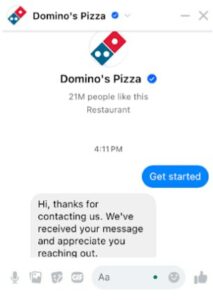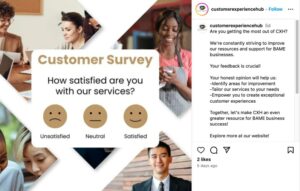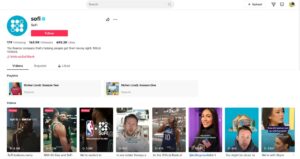There’s just something about being able to log on to an app, scroll through that app, see what everyone is up to, start conversations, tap the like button, share content with people you know….the list goes on. These activities are addictive. Maybe it’s because we’re innately social beings. Or, maybe it’s because we need to kill time. Whatever it is, social media isn’t going anywhere anytime soon.
Is your business leveraging social media to grow to its full potential? If you need some guidance, this blog is packed with actionable strategies to help you crush your social media goals. Learn how to build brand loyalty, discover effective marketing strategies, and find ways to leverage social media profiles to increase brand awareness. Whether you’re using social media for business or looking for ways to leverage social media sites, you’ll find tips on successful social media practices. Explore influencer marketing, understand how to create engaging social media content, and see how successful social media channels can grow your business. Join us as we dive into the world of social media to grow, build brand loyalty, and increase brand recognition through proven social media strategies.
Why Social Media Is Important for Business
The world spends 11.5 billion hours on social media platforms every day. And being active on social media is a great way to reach younger consumers, such as Gen Zers. 82% of Gen Z adults use social media to discover new brands. However, 65% of consumers generally use social media to interact with brands and find new products or services.
Making purchases on social media is also gaining in popularity. Nearly half of social media marketers say their brand sells directly on social media apps. eMarketer estimates US social commerce sales will surpass $100 billion in 2025.
The stats say it all. With so many people active on social platforms, companies can reach a wide audience and build brand awareness. Being active on social media can also help you drive traffic to your website. When more people discover your profile, they might become curious about your brand and click through to your website, creating more sales opportunities and increased revenue.
And because social media sites make it easy for people to interact with each other, you can also leverage these platforms to boost customer engagement.
Whether you foster user-generated content (UGC) through a contest or host a live Q&A session, you can interact with your target audience and humanize your brand. Another valuable benefit of social media marketing is offering excellent customer service.
Just look at brands like Domino’s. Messaging them on platforms like Facebook allows you to easily place an order, track it, or get customer support. Making it easy for people to contact your brand—instead of waiting on hold or a reply to an email—is a great way to boost customer satisfaction.

Social media platforms also allow you to gather valuable market insights. Built-in social media analytics tools help you understand audience behavior, preferences, and engagement metrics. For example, you can create more relevant content that resonates with your audience’s needs and interests. And if you want direct feedback from your target audience, you have access to surveys and polls.
With these insights, you can improve your social media marketing strategy, enhance your content marketing efforts, and get more general feedback on how customers feel about your brand and the customer experience.
Leveraging social media to grow your online presence can significantly contribute to business development. Business owners can build their brand, set clear business goals, and utilize the best social media marketing channels to achieve those goals. Social media helps to reach social media users effectively, providing an excellent platform for building an engaged community.
Incorporating social media strategies, leveraging the power of social media platforms, and maintaining active social media accounts are key steps in maximizing your marketing efforts. Social media is a great tool for business owners to enhance their online presence and achieve sustained business growth.
Selecting the most suitable social media platforms for your business is crucial for building an effective Digital marketing or email marketing strategy. Social media is no longer just a place for casual interactions; it is a vital tool for achieving business goals. Start by looking at your competitors’ social media to see which platforms they use. This can give you an idea of where your target audience might be. Popular social media channels like Facebook, Instagram, and Twitter are commonly used, but you should choose one or more social media platforms that best fit your business needs. Social media can help promote your business and reach a wider audience. Using a social media management tool can make it easier to manage and monitor your social media activities across all social channels.
Effectively using social media involves regular social listening and using social media analytics to understand what works best for your audience. Social media advertising allows you to reach specific groups and increase your brand visibility. Media is a great way to engage with customers and build a loyal following. Remember, social media is a two-way street; interacting with your audience is just as important as posting content. Regularly monitor your social media performance to make necessary adjustments and ensure your efforts are aligned with your overall business goals. Agement metrics like comments, shares, and Instagram likes can give you deeper insights into what content resonates most with your audience.
Here are five tips for selecting the right social media platforms:
- Identify your target audience: Know who your customers are and where they spend their time online.
- Research competitors: Look at competitors’ social media to see which platforms they are active on.
- Consider your content type: Choose platforms that support the type of content you plan to create (e.g., images, videos, articles).
- Use social media analytics: Analyze data to see which platforms drive the most engagement for your business.
- Test and evaluate: Start with one or more social media channels and monitor your social media performance to see which works best.
Crafting a compelling brand identity to resonate with your audience
Crafting a compelling brand identity is vital for connecting with your audience. Your brand identity should reflect what your business stands for and create an emotional bond with your customers. Whether you are a small business owner or have a brick-and-mortar store, social media allows you to show off your brand’s unique personality. Being active on social networking sites helps you build a loyal group of social media followers. Regular social media posts keep your audience engaged and maintain a strong social media presence. Social media also works as a form of word-of-mouth marketing, where happy customers share their good experiences with others.
Using social media in your marketing plan brings many benefits. It helps you reach a broader audience and supports your long-term business goals. Paid social media campaigns can increase your visibility, while regular social media activity keeps your brand in your followers’ minds. Platforms like Facebook, Instagram, and Twitter are great for engaging with your audience and creating a complete brand experience. Use your social media channels to talk to your audience, answer their questions, and build a community. The importance of incorporating social media into your overall strategy is huge, as it strengthens your brand identity and drives business success via social media.

8 Best Practices to Leverage Social Media for Business
Use these best practices to get the most out of social media for your business.
1. Always Post for Your Customer Personas
Make sure you’re targeting your customer personas and segments with your social media posts.
Targeted messaging ensures your content resonates with specific audiences, which leads to more successful marketing campaigns.
74% of marketers say targeted personalization leads to higher customer engagement. It makes sense. Your audience likely won’t engage with your content if it doesn’t interest them.
So, it’s important to understand what type of content they want to see. This means knowing their pain points, motivations, and preferences.
Focusing on precise customer segments can improve key performance indicators (KPIs) such as engagement, conversion rates, and overall return on investment (ROI).
Let’s look at an example of how a company can create relevant content that resonates with its audience.
A divorce mediation firm can use targeted social media to reach individuals navigating a separation. The firm could offer tailored content to capture their interests, such as a divorce mediation guide that gives them valuable advice and resources.
2. Post Where Your Customers Are
Posting on relevant platforms for your target audience is crucial for maximizing engagement and return on investment. It ensures your content reaches the right people who are more likely to interact with and benefit from your offerings.
Cruise America, a company that offers used RVs and RV rentals across the US, has mastered this strategy. The travel industry has a scattered audience across various social media platforms. However, the brand has identified Instagram as a primary platform where most of its audience actively engages.
By focusing heavily on Instagram, Cruise America regularly posts visually appealing and informative content that resonates with its audience. This drives higher engagement rates, increases brand awareness, and ultimately boosts its business performance.

Gather some data to determine which platforms your audience engages with the most. Here are some common ways to get that data:
Market research: If you haven’t already, research your industry to understand customer demographics, including age, location, gender, etc. For example, specific sectors may target younger consumers. This demographic tends to be on platforms like Instagram and TikTok. Demographics can also include job titles or company size. This data is especially relevant if you’re targeting professionals or B2B markets. You’ll typically find this audience on networking sites like LinkedIn.
Social media analytics: Most social media platforms have built-in analytics to help you understand your audience. They often collect data, such as engagement rates, audience demographics, and content performance. If you see that specific platforms get higher engagements than others, it might be a sign that more of your ideal customers are active on those platforms.
Competitor analysis: Look at the platforms your competitors use and how they engage with their audience. This can give you insights into where your potential customers may be active.
3. Utilize Tools to Streamline Workflows
It can be fun to hop on social media to create contests, share giveaways, post memes, and spark conversations with your customers.
But trying to manage everything—from navigating different platforms to planning content—day in and day out can be overwhelming.
That’s why it’s so important to use technology to make things easier.
There are many tools out there that can help you streamline workflows and save time, including:
- Project management software: Organize projects, tasks, and deadlines in one place. This allows team members to collaborate on post ideas, designs, and schedules. Sites like find pm software aggregate project management tools, enabling teams to easily compare and select the best option for their needs. Most of these tools have a visual calendar. So, you can organize posts and campaigns, making it easy to schedule and plan ahead.
- Automation tools: Automate repetitive tasks, such as posting content across multiple social media platforms.
- Document collaboration platforms: Collaborate on social media posts, graphics, and visuals in real time. Store and organize social media assets in a centralized location for easy access.
- Task management apps: Use these to track daily social media marketing tasks, organize your workload, prioritize tasks, and receive reminders for important posting times, deadlines, and engagement tasks.
- Time tracking software: Use it to track the time you spend on different social media marketing activities, such as content creation, engagement, and analysis.
Is social media content creation taking too much of your time? Writecream is another tool you can use to speed up your processes.
Use Writecream’s AI to generate engaging and creative captions for Instagram and other social media platforms in under 5 minutes.
4. Encourage Engagement
Creating genuine interactions with your audience is crucial for understanding their needs and delivering content they will love. Engaging with your followers and knowing what they want helps you create hands-on content that resonates.
Active participation and a well-planned social media marketing strategy also help you build relationships, increase visibility, drive conversions, and enhance your brand image.
Beaches of Normandy Tours is a great example of this. The brand actively interacts with its audience by creating quizzes and sharing tailored blog content that captivates its followers.
One of Beaches of Normandy’s recent quizzes received 5K reactions and 112 comments, showcasing its ability to connect with its audience effectively.
By listening to its audience and delivering engaging content, Beaches of Normandy Tours keeps its followers interested and involved.

Different social media sites have their own unique ways of generating high engagement. Let’s look at some examples of how you can use certain platforms for different purposes.
LinkedIn is perfect for connecting with colleagues and building a network of professionals alike, ultimately allowing for the development of opportunities for collaboration. Let’s say you offer a weight loss program. You could greatly benefit from sharing posts written by your own doctors.
When one of the doctors in the program shares a post about research on the side effects of the Wegovy medication and how to reduce them, it opens the door for other doctors to participate in the conversation. This can help you connect with potential partners or even influencers who could recommend your program to their network.

Facebook is known for community building and interactive content. Facebook Groups and Pages allow you to create communities where you can interact with your audience, share updates, and foster discussions.
Features like live videos, polls, and stories encourage real-time interaction and feedback from your followers.
X (Formerly Twitter)
X’s fast-paced environment is ideal for real-time conversations, trending topics, and timely updates.
When it was Twitter, X was the first social media site to use hashtags, which help increase the reach of your tweets and engage with broader conversations.
TikTok
TikTok’s algorithm promotes engaging content, which makes it easier for videos to go viral and reach a larger audience.
Duets, challenges, and hashtags drive high levels of engagement and participation for users.
5. Nurture Leads Through Your Sales Funnel
As a business owner or marketer, you know that every customer interaction isn’t going to lead to a sale. But it’s your job to do everything you can to increase your brand’s chances of driving conversions.
This requires lead nurturing, which involves engaging, educating, and building trust with leads at each stage of the funnel.
You can attract leads with engaging content, targeted ads, and social media campaigns. Provide value with gated content, landing pages, and social media forms.
But attracting leads is one thing. What about converting them into customers?
Here are some strategies to help you nurture leads down the funnel:
- Lead qualification: Qualify your social media leads by assigning scores based on their behavior (e.g., website visits, email opens, content downloads).
- Lead nurturing campaigns: Implement lead nurturing campaigns using target ads, interactive content, and personalized messages. Offer relevant content at each stage of the funnel to educate and engage leads.
- Content marketing: On your social media platforms, share blog posts, infographics, and engaging videos. Host webinars and live video sessions to educate your audience. Build trust by sharing case studies, reviews, testimonials, and customer success stories.
- Marketing automation tools: Set up automated workflows to send follow-up messages, nurture sequences, and personalized content based on lead behavior and engagement.
- Customer relationship management (CRM) systems: Use a CRM that integrates with social media apps to track leads, monitor their interactions, and manage follow-up activities. Segment these leads based on online behavior, demographics, and engagement levels to deliver more targeted and relevant content.
6. Vary Your Content
Mixing up your content on social media is important to keep your audience engaged and show your business as a leader in your field.
To keep things interesting, share a variety of posts, such as how-tos, quick tips, polls, questions, contests, announcements, and industry news. Using different formats, such as images, videos, live streams, and online stores, makes your content even more engaging.
Take SoFi as an example. The online banking app does a great job of using its social media accounts to share a wide range of financial insights content.

SoFi posts institutional updates, user-generated content, and helpful how-to guides. The brand also interviews influencers to bring fresh insights and relatable stories. This mix helps SoFi connect with its audience and showcase its expertise, creating a lively and engaging online community.
7. Leverage Multiple Channels of Promotion
Social media is a powerful tool for reaching your target audience, building brand awareness, and driving conversions.
But to maximize your results, make sure you’re posting content across multiple channels to reach a diverse audience and increase visibility.
While organic reach offers an authentic way to attract potential customers, you can also use paid methods like ads or influencers to further increase your reach.
8. Explore Influencer Marketing
Influencer marketing continues to be a valuable strategy in 2024, enabling brands to connect authentically with target audiences through trusted voices. There are different types of influencers, all based on size. These include nano, micro, macro, and mega levels. Each offers unique benefits.
Nano-influencers have 1k-10k followers, fostering intimate connections and high engagement.
Micro-influencers, with 10k-100k followers, balance reach and relatability.
Macro-influencers have 100k-1M followers, which offers substantial reach. Mega-influencers, with over 1M followers, provide massive exposure.
StudioSuits, a men’s custom clothing company, uses influencer marketing within the fashion industry.
By partnering with influencers on Instagram and TikTok, StudioSuits showcases tailored products like custom tweed jackets, suits, pants, etc., to diverse audiences, enhancing brand visibility and credibility. These collaborations drive engagement, boost brand awareness, and increase sales.

Final Thoughts
In a world where consumers use online platforms to influence their purchases and perceptions of a brand, being active on social media is a must.
To be successful, you must first understand your audience and create targeted content that keeps them engaged and your brand at the top of your mind.
But with so many things on your plate, how do you find the time for it all? For example, writing great post captions can be tough, especially if you post often and need to tailor your messages for different channels.
You can streamline your social media content creation using an AI tool. Ready to start generating engaging content in minutes? Get started with Writecream for free.

